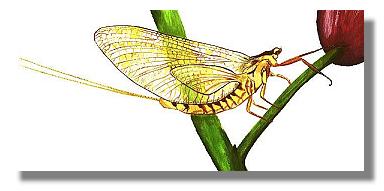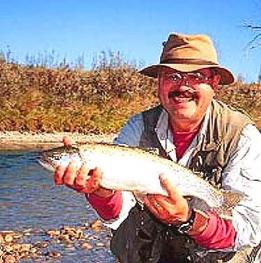Dry-fly fishing
It doesn't get any better
Adapted from "The Essential Guide to Fly-Fishing" by the author
 Dry-fly fishing. The main event.
Dry-fly fishing. The main event.
What we waited for all winter and much of the spring.
But, oh boy, when the trout are looking up, it just doesn't get any
better. I love to nymph and streamer fish, but there is something about
catching trout on dry flies, especially when casting to specific fish
and watching it all happen.
We'd all likely catch more trout if we never tied on a dry fly, but
instead pounded nymphs persistently hour in and hour out, week in week
out at least in many high-plains, foothills and mountain streams. You'll
read articles by some anglers who ignore hatches and rising fish and
cast nymphs of the hatching insect instead of dry flies. They claim to
catch more fish that way even during hatches.
That's fine if numbers are a big deal with you. But do we always
fly-fish to catch a maximum number of fish? Don't get me wrong, I like
to catch trout. But dry-fly fishing is a blast and a rise or two is
often enough to make me break down the nymph gear and try a dry fly. I
may do this if the nymph action has been slow so I have nothing to lose.
I also may try it just for something different even if the nymph fishing
has been good. But mostly I do it because it is just so neat to cast to
rising fish and watch a trout rise to a dry fly.
If the occasional trout is caught on a dry fly during sporadic feeding
periods perhaps only one or two trout instead of the five you might have
caught during the same period on nymphs that's okay. In fact, it's
pretty satisfying. It could be easy to become smug and think of yourself
as a very cool and selfless angler for catching a few trout on dries,
when you "coulda slayed 'em" on nymphs. But there's no need be become
boastful about it. You caught several fish on nymphs yesterday and fewer
today on dries. It was different. You had fun as you always do and
that's all that counts.

Once in a while hatches and feeding fish can be difficult to figure out
because it may not be apparent what the trout are eating. You can see
adult mayflies or whatever on the surface, and you see trout eating
something, but no matter what imitation you try, they ignore everything.
The #16 light mayfly dry was the first you tried, but that was six or
eight patterns ago. Damn, what are they eating? Reminds me of when Butch
Cassidy turned to the Sundance Kid and asked, "Who are those guys?"
It could be one of those masked hatches, where there's a less obvious
insect on the surface that the trout are feeding on and you don't notice
it. Or the trout are locked on emergers, and you think they're eating
adults. Or they're eating spinners that hatched yesterday and are dying
today in the midst of today's new crop of adults. It's doubly satisfying
to get one of these tough hatches figured out. But it's frustrating if
the hatch comes and goes before you find the solution. It's happened to
me before and will happen again.
But the best hatches of all are the "no brainers." You see the insects
hatching on the water and you know what they are: say, #16 pale
mayflies. The guy at the fly shop said something about Pale Morning
Duns, but to you they are smallish pale-colored mayflies. You catch one
of the natural insects in your hat and they're quite pretty. There is no
mistake with this hatch because you watched a few duns floating along
and they all disappeared in quiet rises. You tie on the appropriate
imitation dry, and bingo. Trout are caught. The trout are on, and you've
got them figured out.

During a hot hatch, after you've landed a few fish was it five or
seven? you momentarily think about wading to shore and relaxing while
you watch fish rise. Maybe have a cigar. It is permitted; after all,
you're in the smoking section. But you regain your senses remembering
all the times when the trout weren't rising and you contentedly fish the
hatch to the end, catching three or four more before the bugs and the
rising dwindles. You feel cheery and content. Lord knows you've paid
your dues in the past few weeks. This will make some good storytelling
with the gang when you get back.
Hatches never last forever. Perhaps a couple of hours if you live a
charmed life. Only a few minutes sometimes. A full-blown hatch should
never be ignored because you just never know when the bugs, the trout
and you will be at the same coordinates again. You can show up tomorrow
at the same time and same place and under the same sky. The wind has
stayed down again for the second day in a row, and according to the nice
man at the local fly shop, this is a solid hatch and will go on for at
least one more week. And . . . nothing.
This week's closing thought is from
Groucho Marx:
The secret of life is honesty and fair dealing.
If you can fake that, you've got it made.
Our Man In Canada Archives
Bio on Our Man In Canada

Clive Schaupmeyer is an outdoor writer and
photographer. He is the author of The Essential Guide to
Fly-Fishing, a 288-page book for novice and intermediate fly
anglers. His photo of a boy fishing was judged the best outdoor
picture of 1996 published by a member of the Outdoor Writers
of Canada. He fly-fishes for trout in Alberta's foothill and
mountain streams and for pike near his home in Brooks,
Alberta.
For information on where to find, or how to get a copy of
Clive's book, Click here!
|

 June 15th, 1998
June 15th, 1998



